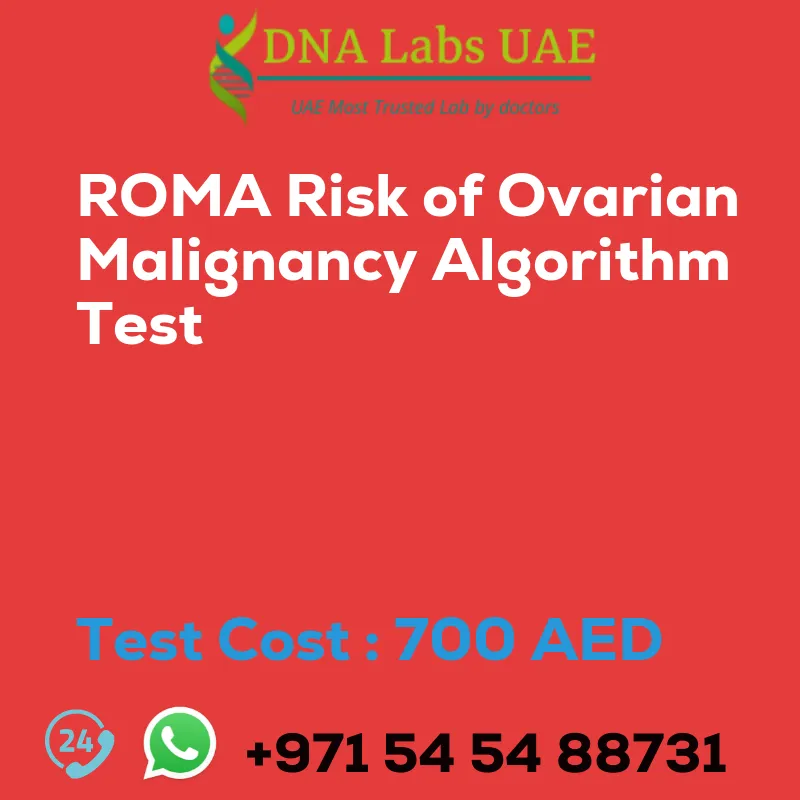ROMA RISK OF OVARIAN MALIGNANCY ALGORITHM Test
Test Name: ROMA RISK OF OVARIAN MALIGNANCY ALGORITHM Test
Components: CA125, HE4, Menopausal status risk estimation
Price: 700.0 AED
Sample Condition: 2 mL (1 mL min.) serum from 1 SST. Ship refrigerated or frozen. Provide menopausal status of the patient.
Report Delivery: Sample Mon / Thu by 4 pm; Report Same day
Method: Chemiluminescent Microparticle Immunoassay
Test type: Cancer-Ovarian
Doctor: Oncologist, Gynecologist
Test Department:
Pre Test Information: Provide menopausal status of the patient.
Test Details:
The ROMA (Risk of Ovarian Malignancy Algorithm) test is a diagnostic tool used to assess the risk of ovarian malignancy in women with a pelvic mass. It combines the measurement of two biomarkers, CA125 and HE4, with menopausal status to provide a risk score.
The test involves taking a blood sample from the patient and measuring the levels of CA125 and HE4. CA125 is a protein that is often elevated in women with ovarian cancer, while HE4 is another biomarker associated with ovarian malignancy. The levels of these biomarkers, along with the patient’s menopausal status, are used to calculate a risk score.
The ROMA test is particularly useful in distinguishing between benign and malignant ovarian masses. It is recommended for women who have a pelvic mass and are scheduled for surgery. The test can help guide the decision-making process regarding the need for surgery and the type of surgery required.
The ROMA test is not a definitive diagnostic tool for ovarian cancer but rather provides an assessment of the risk of malignancy. Further imaging tests, such as ultrasound or CT scan, and sometimes a biopsy, may be required to confirm the diagnosis.
It is important to note that the ROMA test is not recommended for routine screening of ovarian cancer in asymptomatic women, as it is specifically designed for women with a pelvic mass. Additionally, the test may not be as accurate in women with certain conditions, such as endometriosis or pregnancy.
Overall, the ROMA test is a valuable tool in the evaluation of women with pelvic masses and can help in the decision-making process regarding surgery. However, it should always be interpreted in conjunction with other clinical and diagnostic findings to ensure accurate diagnosis and appropriate management.
| Test Name | ROMA RISK OF OVARIAN MALIGNANCY ALGORITHM Test |
|---|---|
| Components | *CA125 *HE4 *Menopausalstatusriskestimation |
| Price | 700.0 AED |
| Sample Condition | 2 mL (1 mL min.) serum from 1 SST. Ship refrigerated or frozen. Provide menopausal status of the patient. |
| Report Delivery | SampleMon / Thuby 4 pm;Report Sameday |
| Method | Chemiluminescent Microparticle Immunoassay |
| Test type | Cancer-Ovarian |
| Doctor | Oncologist, Gynecologist |
| Test Department: | |
| Pre Test Information | Provide menopausal status of the patient. |
| Test Details |
The ROMA (Risk of Ovarian Malignancy Algorithm) test is a diagnostic tool used to assess the risk of ovarian malignancy in women with a pelvic mass. It combines the measurement of two biomarkers, CA125 and HE4, with menopausal status to provide a risk score. The test involves taking a blood sample from the patient and measuring the levels of CA125 and HE4. CA125 is a protein that is often elevated in women with ovarian cancer, while HE4 is another biomarker associated with ovarian malignancy. The levels of these biomarkers, along with the patient’s menopausal status, are used to calculate a risk score. The ROMA test is particularly useful in distinguishing between benign and malignant ovarian masses. It is recommended for women who have a pelvic mass and are scheduled for surgery. The test can help guide the decision-making process regarding the need for surgery and the type of surgery required. The ROMA test is not a definitive diagnostic tool for ovarian cancer but rather provides an assessment of the risk of malignancy. Further imaging tests, such as ultrasound or CT scan, and sometimes a biopsy, may be required to confirm the diagnosis. It is important to note that the ROMA test is not recommended for routine screening of ovarian cancer in asymptomatic women, as it is specifically designed for women with a pelvic mass. Additionally, the test may not be as accurate in women with certain conditions, such as endometriosis or pregnancy. Overall, the ROMA test is a valuable tool in the evaluation of women with pelvic masses and can help in the decision-making process regarding surgery. However, it should always be interpreted in conjunction with other clinical and diagnostic findings to ensure accurate diagnosis and appropriate management. |







